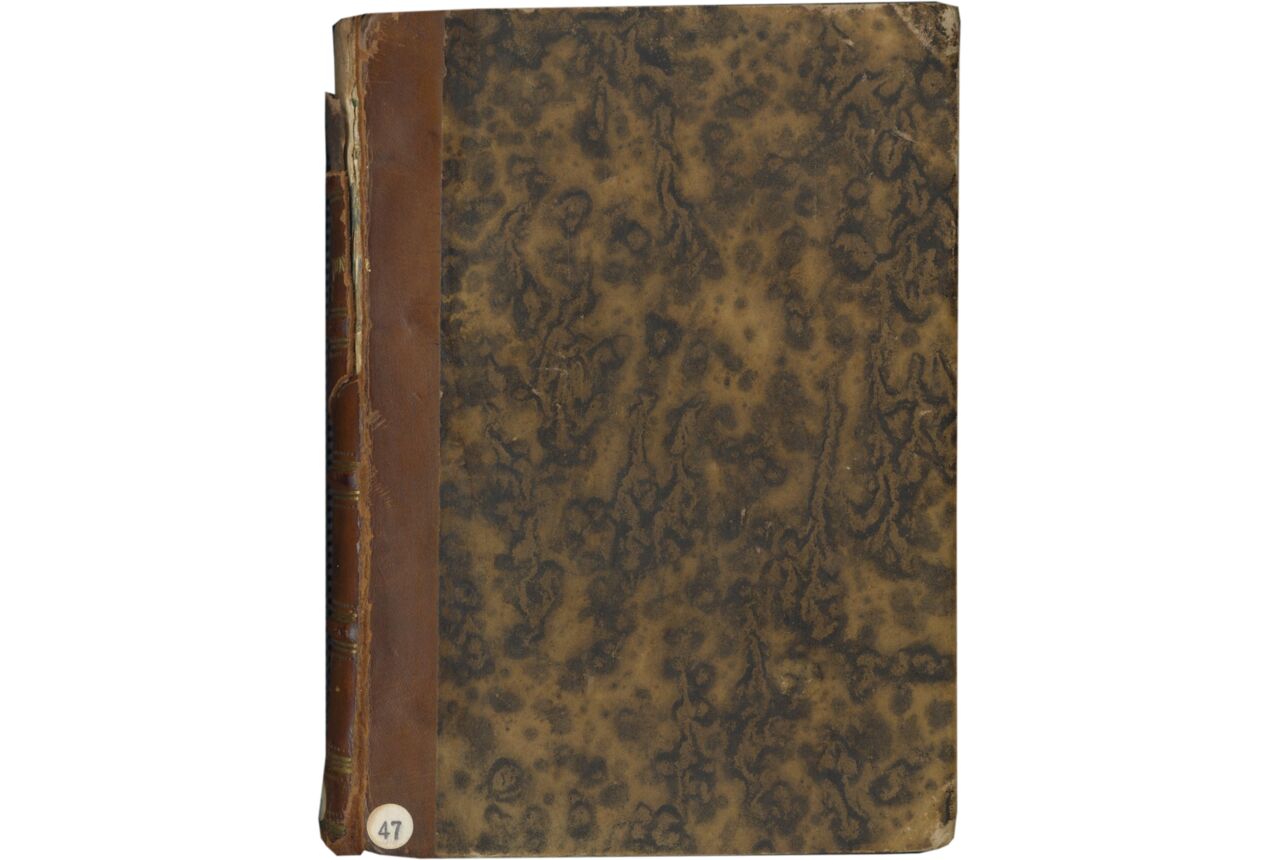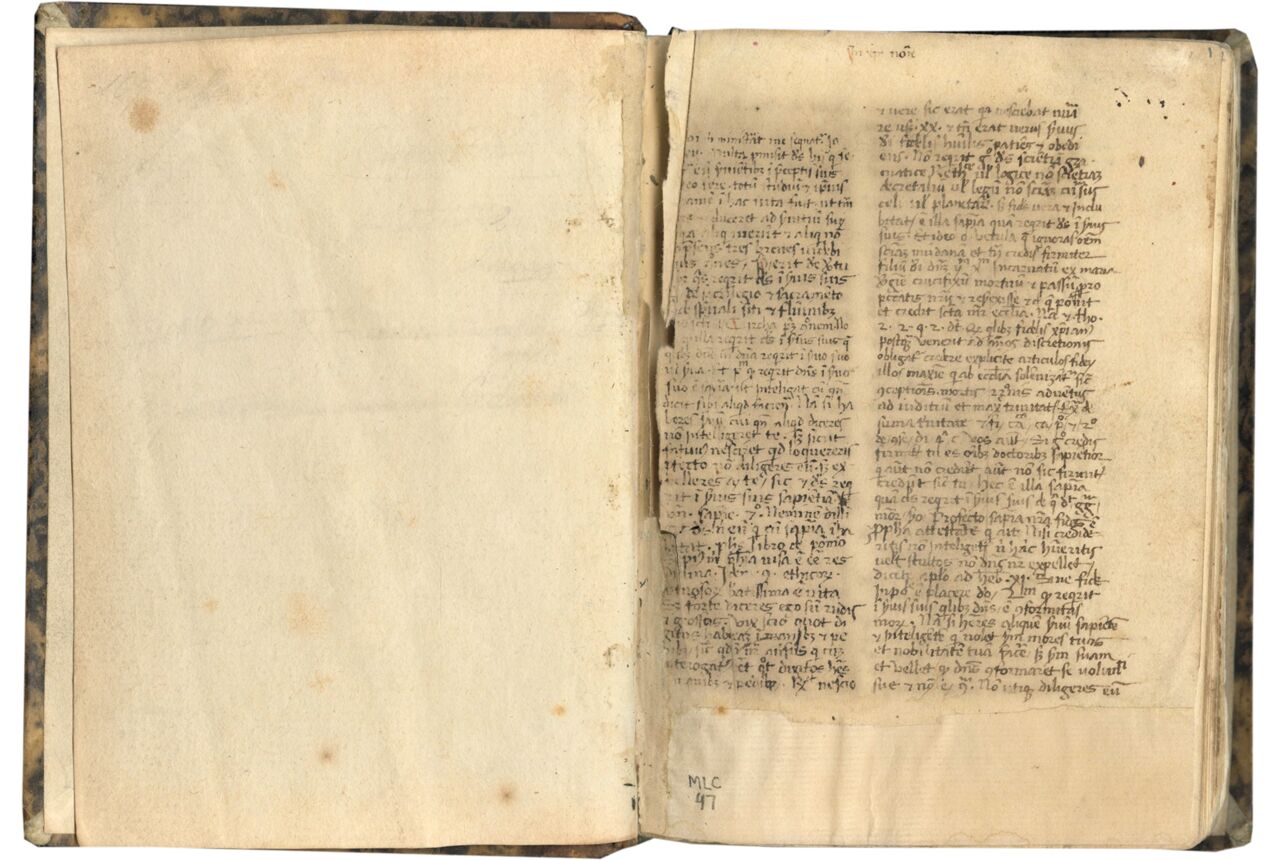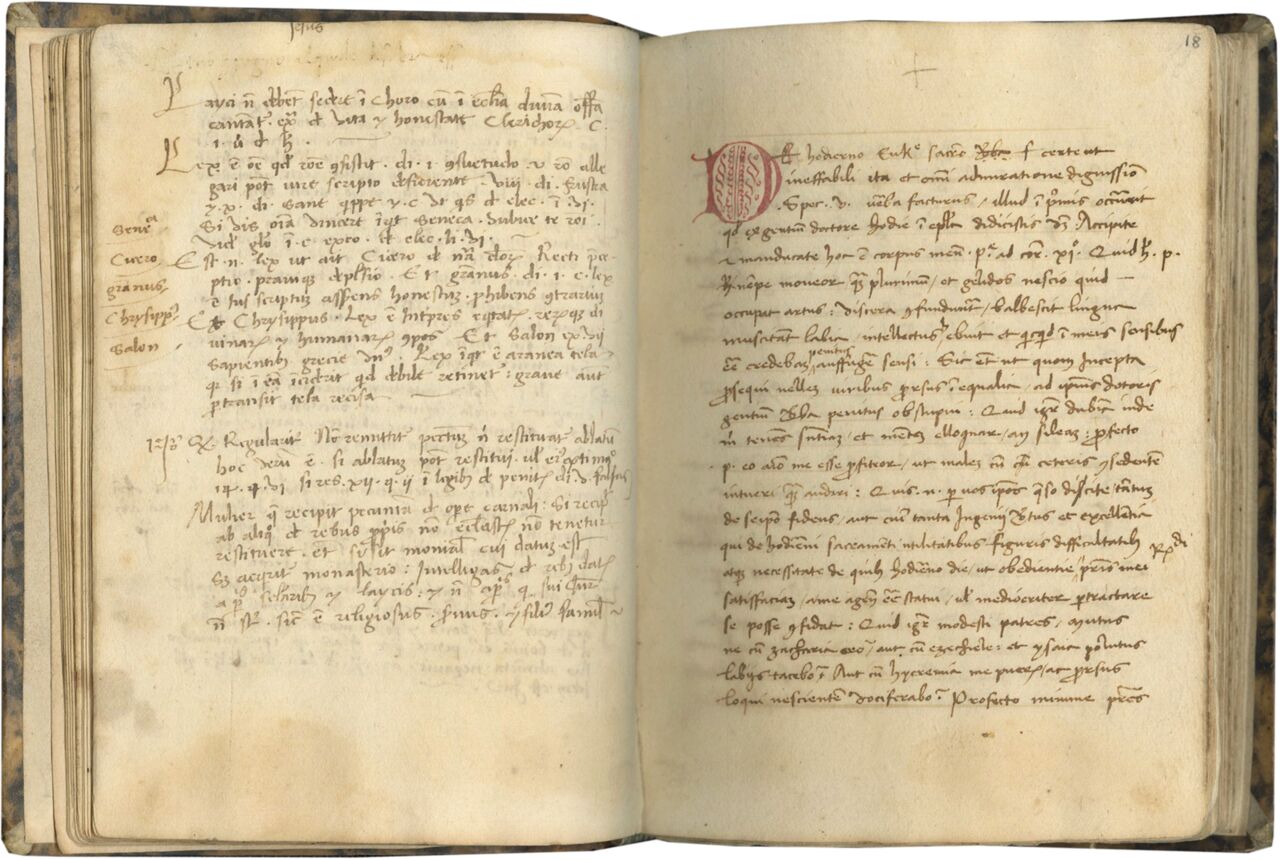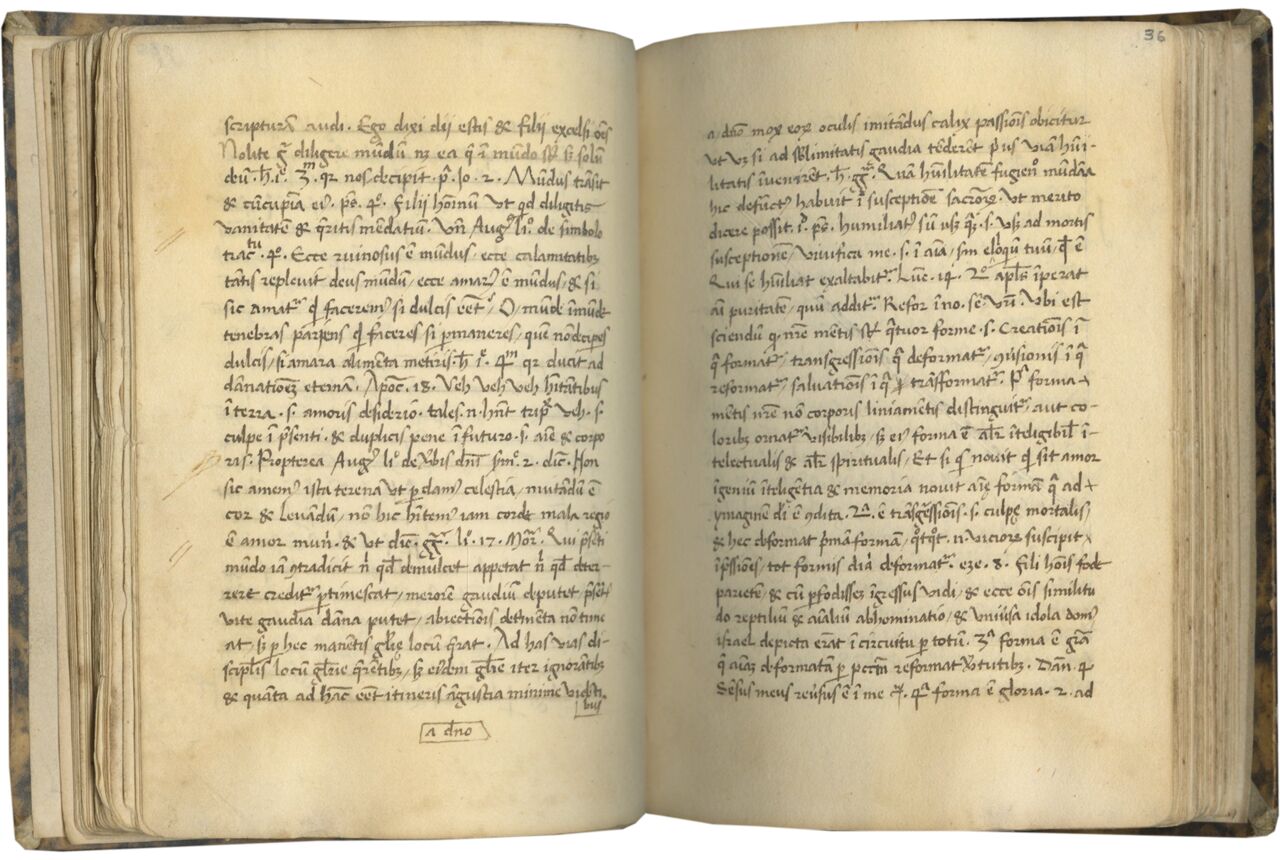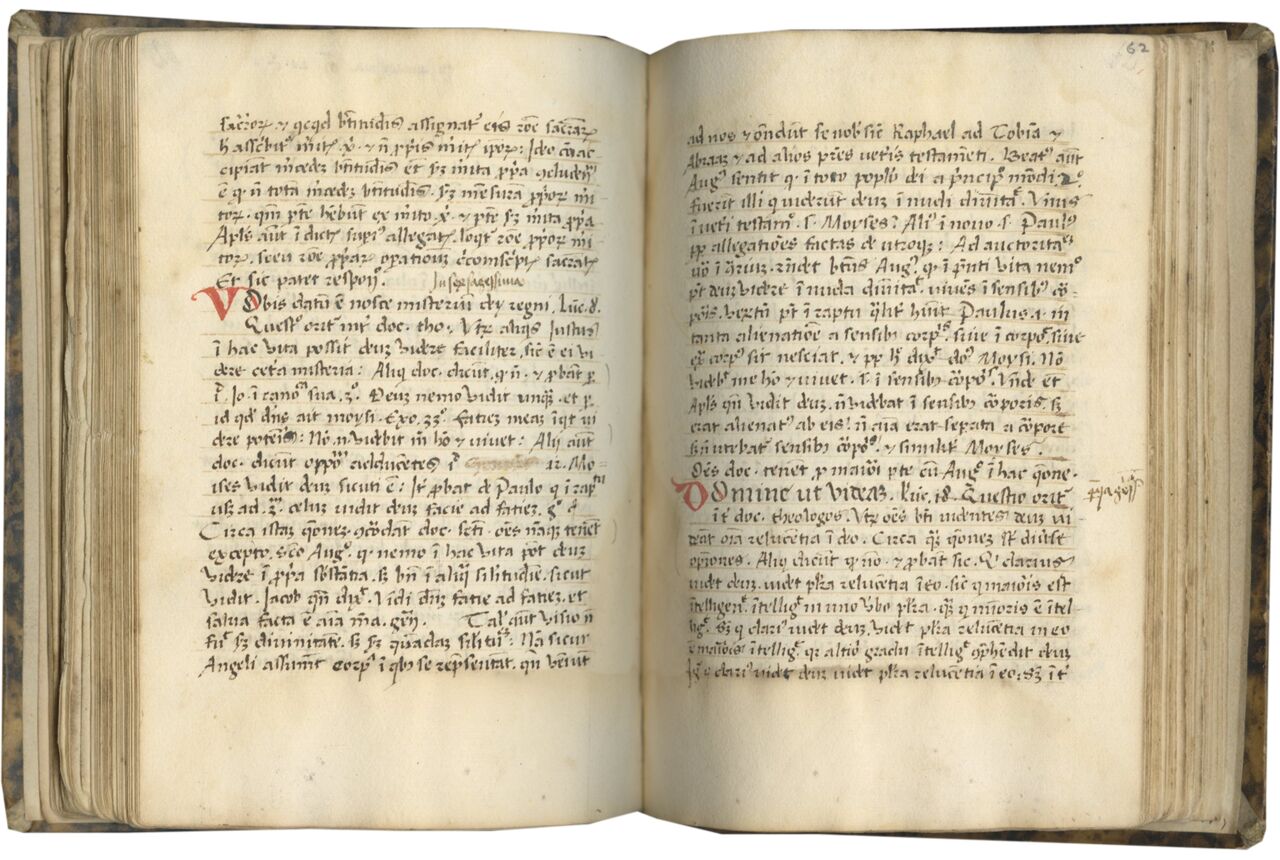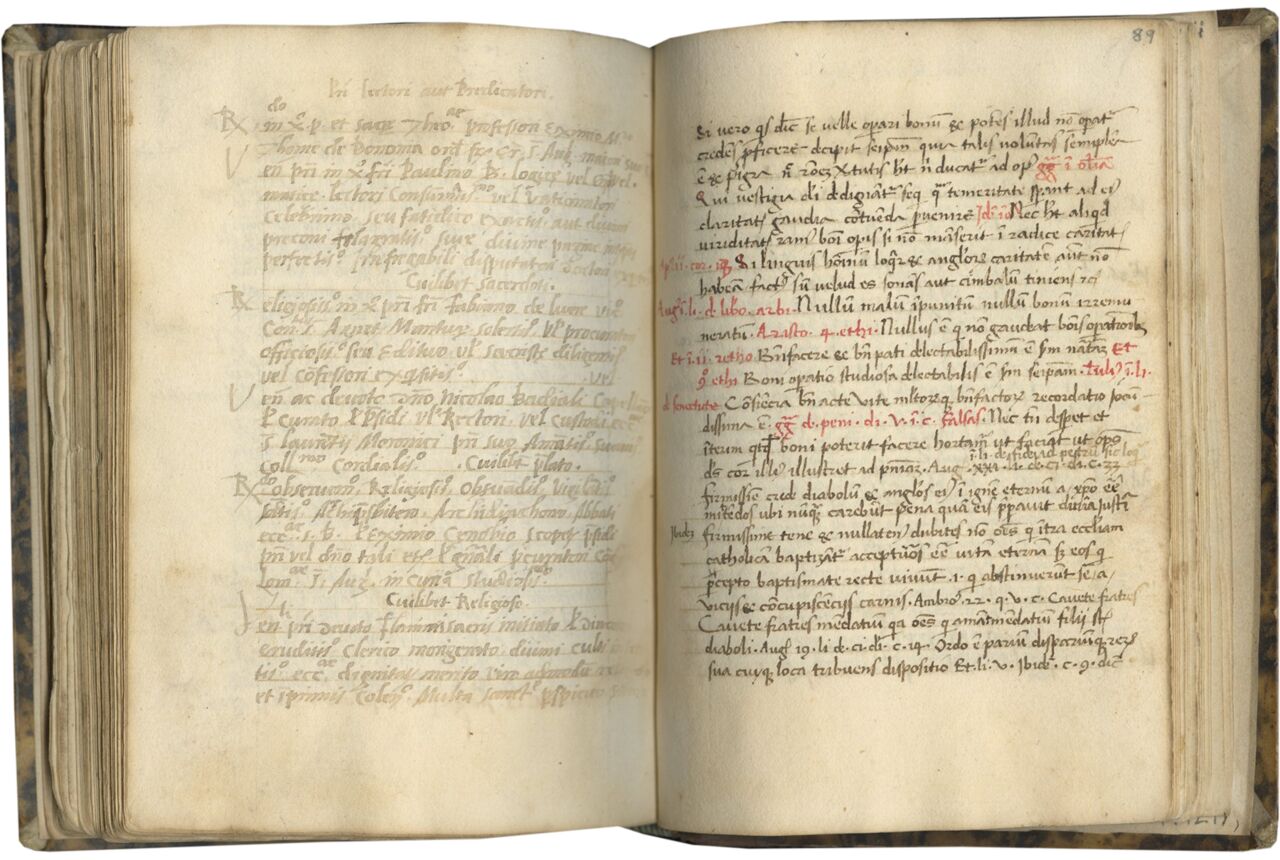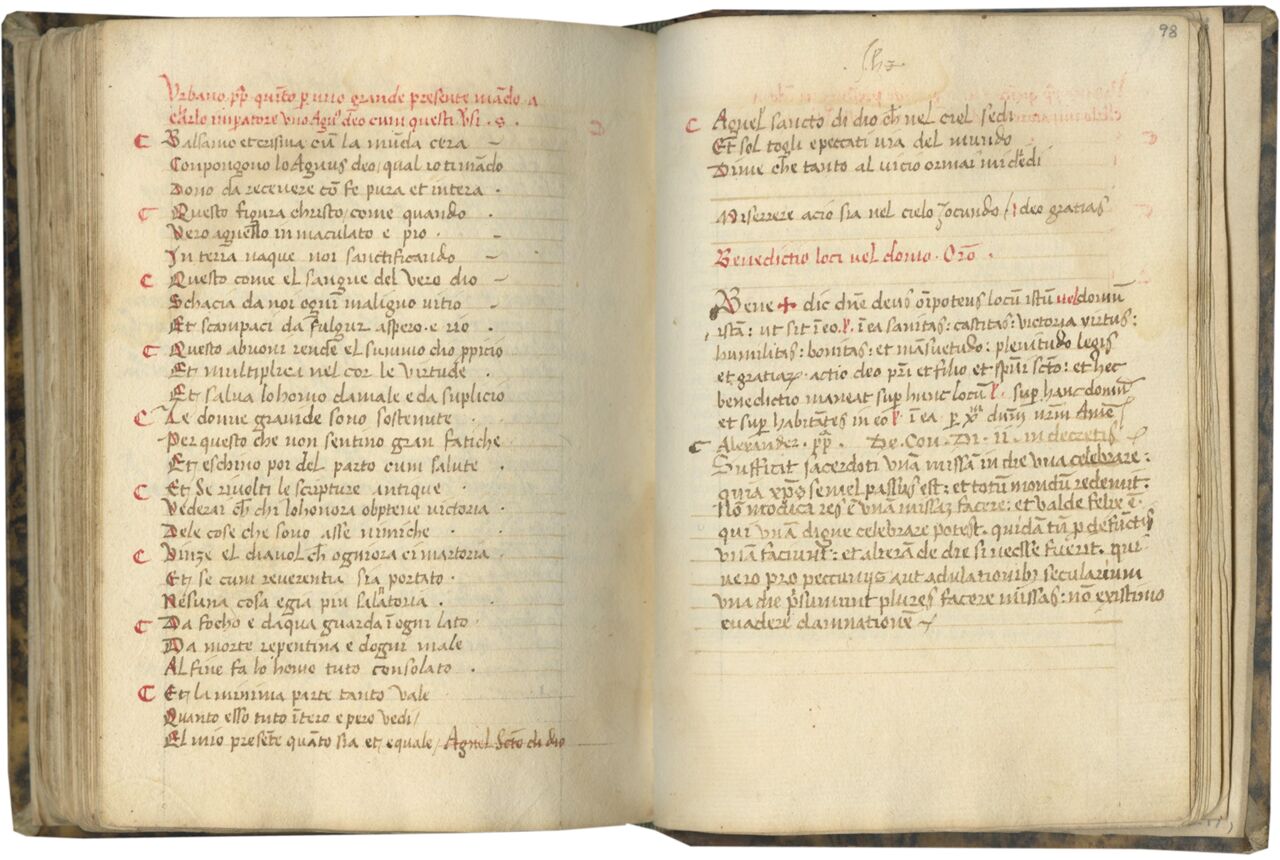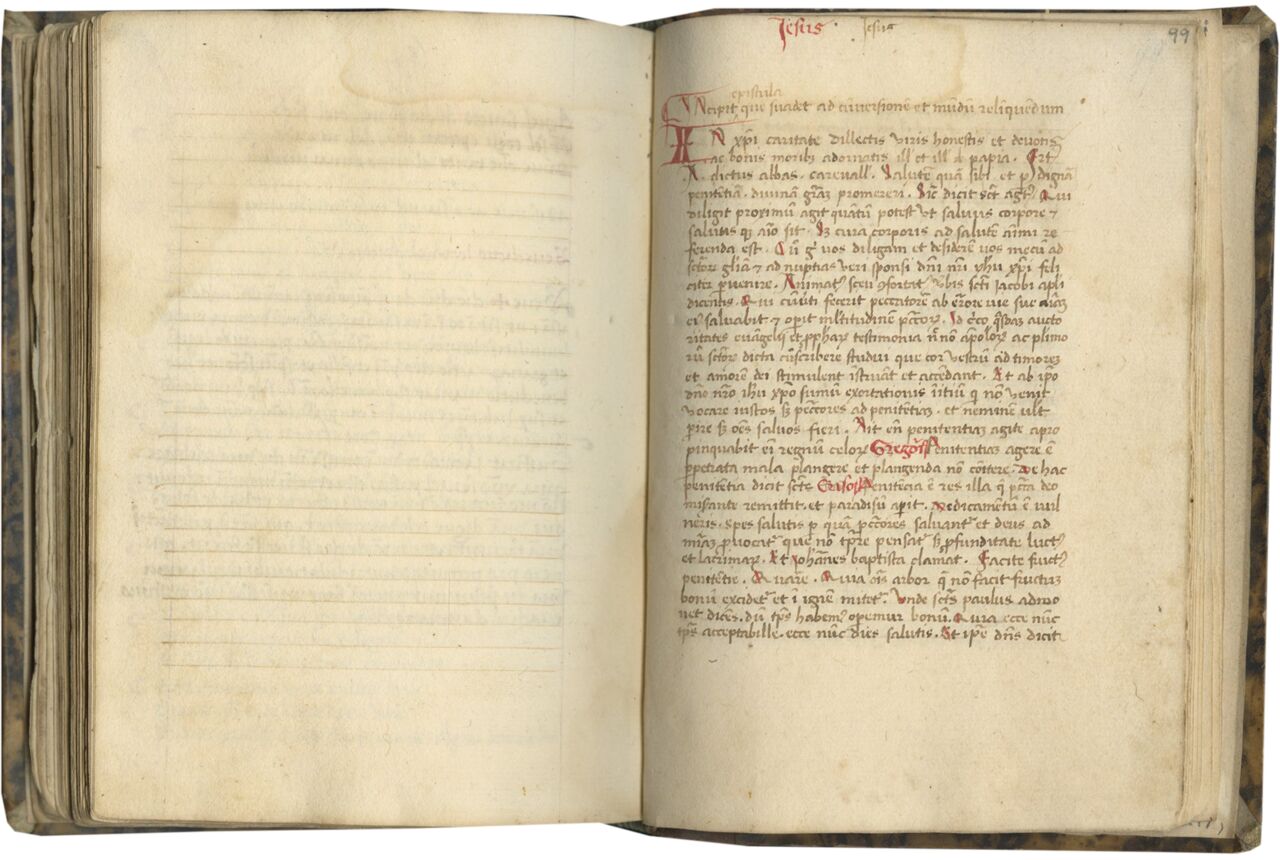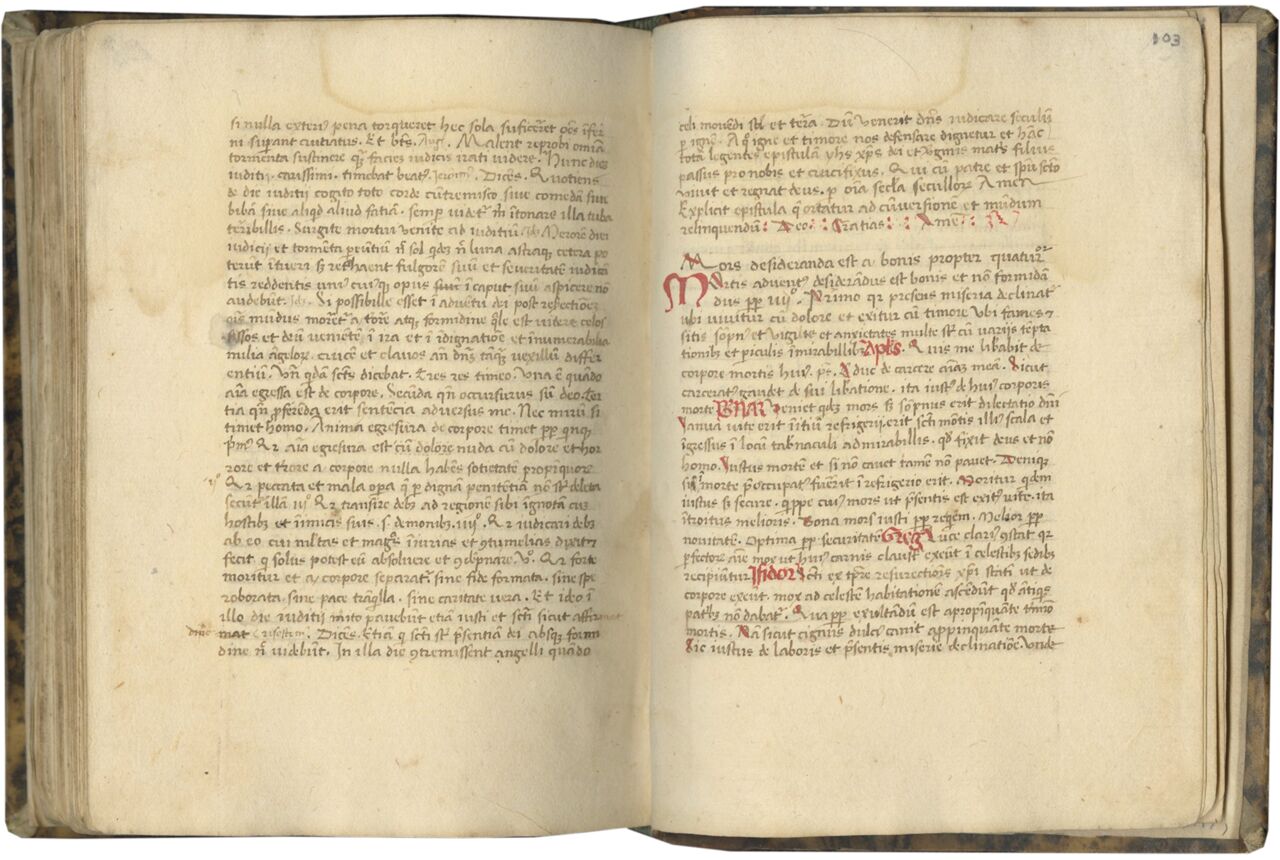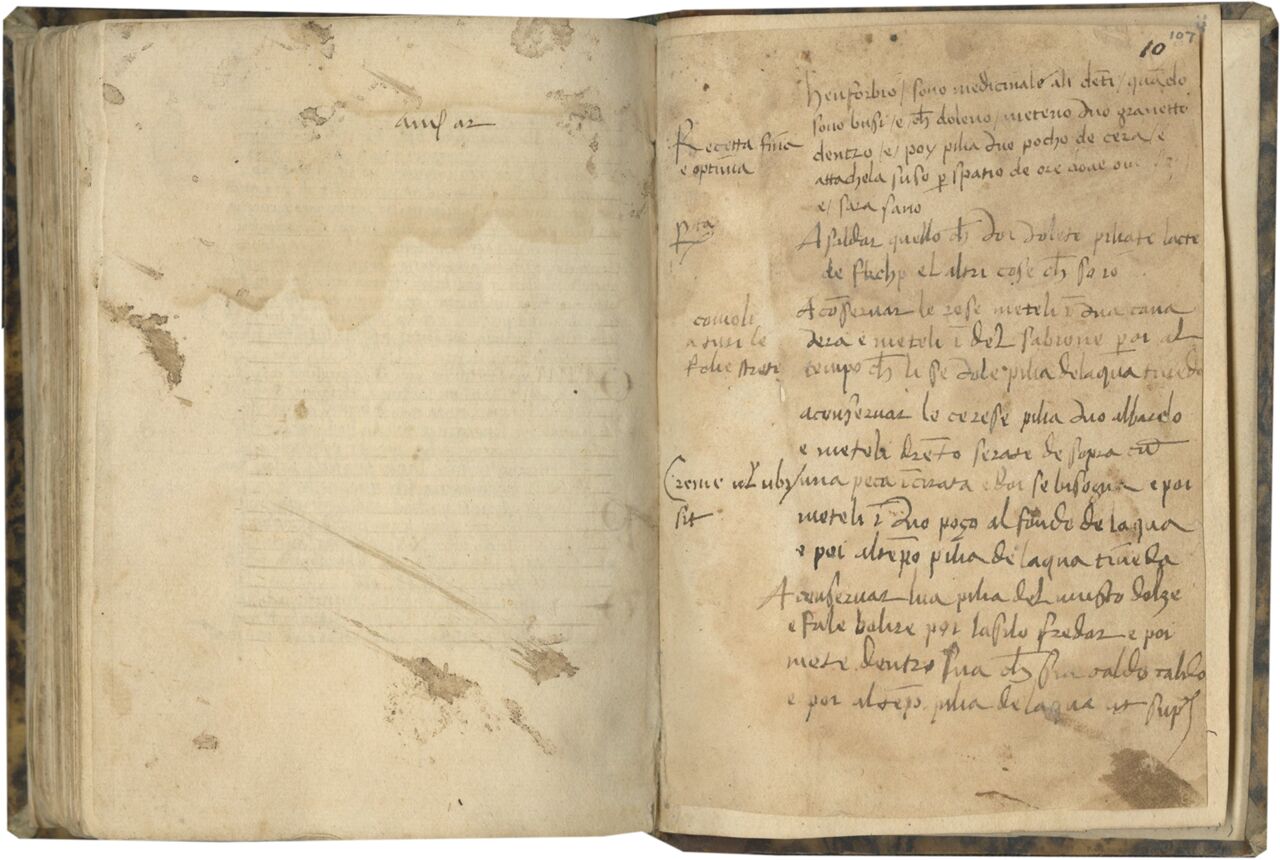i + 107 + i folios on paper, watermark similar to Briquet no. 4659, Couronne à un fleuron et deux demi (Milan, 1473; Legnano, 1475), modern foliation in pencil top right, binding too tight for collation, frame ruled in lead in 2 columns of 37 lines (ff. 1-8v), frame ruled in lead in 22-28 long lines (ff. 9-106), (ruled space 95 x 68 mm.), several hands, mainly small, early humanist textualis hands, with Gothic features, “9” abbreviation for con, “2 shaped” r, a mixture of uncial and upright d (ff. 1-17, 26-87, 89-92, 99-106) and a rapid, flat humanist cursive (ff. 18-25), a humanist textualis (f. 88), a humanist cursive (ff. 93v-97), an angular humanist textualis (ff. 97v-98), a rapid humanist cursive in a later hand (16th century?) (f. 107), three manicules (f. 14), three-line decorated capital in red ink (f. 18), display script in Gothic textualis (ff. 62-87v), folios 24 and 25 loose, light staining in the bottom margin (ff. 15-89), in good condition otherwise. 19th century quarter-calf, gilt spine, titled SERMONI E CONSOLAZIONI, MORALI, spine chipped at the top and loose in the middle connected to binding on only the left edge, otherwise intact and in good condition. Dimensions 140 x 97mm.
This small, eclectic miscellany contains a treasure trove of sermons, rhetorical formulae, medicinal recipes, moral exhortations and prayers, and a single poem. The small size suggests that the manuscript was used for personal devotion and note-keeping, but the presence of different hands and ruling formats make it clear that the manuscript was composed by several scribes and must have been shared by a community. The contents of the manuscript, mostly unedited, likely reflect the intellectual interests of an Augustinian community in Northern Italy, perhaps the Veneto, in the Quattrocento. Notable texts include what may be the unique copy of an Italian translation of a poem written by Pope Urban V, unstudied sermons that possibly can be added to oeuvre of Simon of Cremona, and medical recipes in Latin and Italian.
Provenance
1. This manuscript was probably composed in the middle of the fifteenth century in Northern Italy, c. 1440-1480, perhaps in the Veneto. The most identifiable author in the compilation, Simon of Cremona, spent many years preaching in Venice. The presence of anonymous sermons related to his known sermons (ff. 26-57) may suggest an origin in the Veneto, as does the text found on f. 88. The monastic affiliations of the authors, Simon, an Augustinian, Bruno, a Cistercian, and Urban V, a Benedictine, make the miscellany eclectic, but the bulk of the material is Augustinian.
2. Owned by Marvin Colker, (1927-2020), Professor of Classics at the University of Virginia, and renowned paleographer, who catalogued the manuscripts of Trinity College Library, Dublin, and who assembled an impressive collection of medieval material. Colker’s shelfmark “MLC 47” can be seen on f. 1. He acquired the MS in 1964 from Maggs Bros.
Text
ff. 1-2v, [Theological instructions on how to be a good servus Dei], incipit, “mihi ministrant me sequitur … Sed a Samaritano qui interpetratur [sic] custos .i.”;
An anonymous fragment of a treatise on how to be good servus Dei (servant of God). The text contains citations to Aristotle’s Ethics and Thomas Aquinas’ Summa Theologiae and is thus perhaps a Dominican in origin.
ff. 3-17v, Dicta et auctoritates multorum sanctorum ac prophetarum extractas a pluribus libris, incipit, “In primis lux doctorum Augustinus libro quinto De civitate Dei … sicut est religiosus servus et filius familaris”;
A collection of excerpts from the bible and classical authorities (chiefly Augustine and Seneca) for various rhetorical circumstances. Subheadings throughout the text list the circumstances, such as (f. 4) Ad laudandum aliquem de bono opere et vita et fama (For praising someone because of their good work, life, and reputation) or (f. 10) Ad petendum elemosinam (For seeking alms). The largest section (ff. 14-16) consists of a list of quotations from Seneca, and one from Boethius, and contains several manicules with nota signs in the margins. The final section (f. 16v-17v) contains two hexameter poems and a series on notes on various topics like dividing an inheritance and how to receive fugitive monks back into a religious community.
ff. 18-25, [Three anonymous sermons], incipit, “De hodierno Eukariste sancto sed certe ut ineffabili … in primis unum parentibus vicerat”; [f. 25v, blank].
These sermons on religious subjects appear to be unedited. The first deals with the Eucharist (f. 18-21v); the second with the virtues of humility and clemency (22-23v); the third with the nativity of Christ (ff. 24-25).
ff. 26-57, [Simon of Cremona(?), Sermones], incipit, “His fieri incipientibus levate capita vestra quoniam appropinquat redemptio vestra. Luca 21. Lux doctorum Augustinus libro Omeliarum. Omelia 47 sic inquit: Gaudeat … Absterget Deus omnem lacrimam ab oculis eorum”;
The text of the sermons, 18 in total, do not seem to be transmitted elsewhere. There are modern notes in pencil at the beginning of some sermons (ff. 29v, 32v, 36v, 38, 39v, and 41) marking the liturgical occasion for each and noting the biblical theme (e.g. “EV” for “evangelium” at f. 41). However, there are striking stylistic similarities to Simon of Cremona’s known sermons. See, for example, the citation from Augustine after each scriptural theme that introduces the sermon on f. 41 “Congregate triticum in horeum meum. Matt. 12. Lux doctorum Augustinus [in] libro Soliloquiorum c. 29 sic ait…” (Gather the wheat into my barn. Matthew 12 [recte 13.30] The light of doctors, Augustine, in the Soliloquies thus says…). Simon uses the same phrase at the beginning of a sermon found in Innsbruck, Universitäts- und Landesbibliothek Tirol, Cod. 939, f. 179rb “Beati oculi qui vident. Luc. 10. Lux doctorum Augustinus [in] libro De novo cantico sic inquit…” (Blessed are the eyes that see Luke 10. The light of doctors, Augustine, in the book On the New Song, thus says…) (manuscripta.at). The identical phrasing and frequent citation of Augustine in the Innsbruck copy of Simon of Cremona and in our manuscript suggests that our manuscript may contain hitherto unknown sermons of Simon or may be a later Augustinian production influenced by Simon’s sermons.
Simon of Cremona was born sometime in the first half of the fourteenth century. He spent much of his life in Venice, where he was renowned in the Augustinian order for his learning and his talents as an orator. In 1385 he was promoted to the office of Provincialis of Insubria (near Milan). In 1387 he became the Regens S. Augustini of Geneva and the Visitator Generalis of the convent of Savona. In 1388, he was given the authority to establish a Prior and Lectors in the Augustinian monastery at Geneva. From there, in 1390, he left for Padua, where he disappears from the historical record. He was a prolific writer, but his works largely remain unedited (Zumkeller, 1966, nos. 786-88, for a full list of manuscripts that contain Simon’s works). He is credited with numerous sermon collections including Sermones super evangelia per annum Venetiis habiti (Sermons on the Gospels throughout the year given in Venice) and Sermones de Epistolis dominicalibus (Sunday Sermons). Simon also composed sets of questions on the Sentences of Peter Lombard and on the Blood of Christ. (Perini, 1929, 1:271-73).
ff. 57v-60, [Collection of notes], incipit, “Affinitas contracta inter consanguineos viri et uxorem eius…Bonus Monachus vix bonum clericum facit. Aug. lb. 4. 1. legi”; [ff. 58v-59 and f. 60v, blank];
A set of notes dealing with consanguinity, bigamy, clerks, along with an elegiac distich attributed to Augustine, “Quisquis amat dictis absentum rodere vitam / hanc mensam indignum nouerit esse sibi” (Whoever loves to nibble at the life of the absent with words should know that he is unworthy of this table).
ff. 61-87v, [Sermons for Lent], incipit, “Voca operarios et redde illis mercedem suam: Matt 20. Questio est inter doctores theologos, utrum merces in alia vita reddatur…conciliis quae proprie haberet plenam auctoritatem…”;
This anonymous collection of sermons have been annotated by a slightly later hand which adds “in Septuagesima Mt 20 co” to the top margin of f. 61, “in Sexagesima” on f. 61v, “Quinquagesima” on f. 62, ending with the note “feria quarta” f. 87v (for the week “dominica de passione” f. 84v). The sermons are short and meant to be read through the Lenten season.
f. 88rv, [list of addresses to religious figures], incipit, “Reverendissimo in Christo priori Magistro Gabriele Veneto Theologorum…et in primis colendo multa sanctitate perspicuo…”;
The list of names present on this folio seem to be intended as examples of how to properly address religious superiors (most likely intended for use by writers of letters). The addresses are grouped under the headings “Priori Generali,”“Episcopo,” “Priori Vicario Congregationis,” “Patri Priori,” “Priori Visitatori,” “Priori Lectori aut Predicatori,” “Cuilibet Sacerdoti,” “Cuilibet Prelato,” and “Cuilibet Religioso.”
ff. 89-91v, [Collection of excerpts on the doing of good works], incipit, “Si vero quis dicit se velle operari bonum…qui potest et non ieiunat senciet penam”;
The collection contains excerpts mostly from Augustine, Aristotle, and the Bible.
f. 92rv, [Excerpts on death and eternal life], incipit, “Mortua est quidem hominibus sed non deo…Dominus mortificat et vivificat deducit ad inferos et reducit”; [f. 93, blank];
The first excerpt is titled “Pro mortuis. Bernardus”, but non such text has been edited in the works of Bernard of Clairvaux. Other excerpts are taken from Jerome, Augustine, and the Bible.
ff. 93v-97, [Medical recipes in Italian and Latin], incipit, “Alle donne quando diventino pare per non essere…lo in corpori et non lo lassone tropo cofere”;
A collection of medical and chemical recipes, including a recipe for ink and a salve to treat genital pain in either sex. Twenty recipes in all: Alle donne (for women) f. 93v; Alla pura del fiato (for good breath) f. 93v; Ad faciendam bonam vocem (for a clear voice) f. 94; A chi avesse la tegna (?) f. 94; A dolori di fianchi (For hip pain) f. 94; Chi fusse stretto di petto (For tightness of the chest) f. 94; A fare bono inchiostro (To make good ink) f. 94v; A uno chi havesse qualche desesa e non potesse havere la voce (For someone who wants and does not have a voice) f. 95; Ad faciendum capillos albos (For bleaching hair) f.95; A correr via le mosche (To get rid of flies) f. 95; A la madre (For a mother) f. 96; Ad crepalinas manum (For crackly hands) f. 96; Pilia lo osmarino (Recipe with rosemary) f. 96; Item questa herba (Another rosemary recipe) f. 96; Contra la rogna (Against scabies) f. 96v; Per fare aqua per quelli chi sonno afredati (Making a drink for those who are chilled) f. 96v; Al male delle membri genitali utriusque sexus (For genital ills of either sex) f. 96v; Serpentina est radix valde bona (Note on the plant serpentina) f. 96v; A guarire il dolore dil ventre (To heal stomach pain) f. 97; Contra la quastana(?) f. 97; Al male de gombe che viene per Calidita (?) f. 97.
f. 95v, Prophetia habita a quodam sancto nuper defuncto de partibus Alamannie [A prophecy given by a holyman recently deceased from Germany]. incipit, “Nam auis stans promptaque volans in aere…necabunt aprum qui iam multas ligauerat urbes”;
A prophetic text that is perhaps an allegory of recent political events in Germany and Italy.
ff. 97v-98, Vrbano papa quinto per uno grande presente mando a Charlo imperatore uno Agnus deo cum questi versi .s., incipit, “Balsamo et crisma cum la munda cera … Miserere acio sia nel cielo jocundo. Deo gratias”;
A poem of thirty lines in terza rima commemorating a gift of an Agnus Dei from Pope Urban V (pope, 1362-1370) to the Emperor Charles IV (Holy Roman Emperor from 1355-1378). Agnus Dei were ceremonial seals made from clean, white wax and blessed by the pope himself in the first and seventh years of his pontificate. They carried great ceremonial and sacred power and were sometimes given as gifts. The process of making and blessing Agnus Dei is reported in the Pontifical of Patrizi Piccolomini (Dykmans, 1980-82, 1:136-39 and 2:418-20), who also mentions the gift of an Agnus Dei by Urban V to the imperator Grecorum (emperor of the Greeks) and appends the incipit of this poem, but written in Latin hexameters: “Balsamus et munda cera cum chrismatis unda” (Dykmans, 1980-82, 1:139). The poem in Italian is unedited and its translator unknown.
f. 98, [Prayer and decretal of Alexander II (d. 1073)], incipit, “Benedictio loci vel domo. Oratio … non existimo evadere damnationem”; [f. 98v, blank];
The prayer and decretal seem to be completely unrelated. The prayer is intended to bless a place or home, while the decretal of Alexander II enjoins priests to only celebrate one mass per day.
ff. 99-103, Incipit epistula que suadet ad cumversionem et mundum reliquendum, incipit, “In Christi caritate dillectis viris honestis et devotis ac bonis moribus adornatis …,” Explicit epistula que ortatur ad cumversionem et mundum reliquendum: Deo : Gratias : Amen”;
Also known as the Epistula que confortat ad conversionem et mundum reliquendum, this text, written by Brunus Abbas Clarevallis (spelled “Carevallis” in the In Principio database) Mediolanensis, survives in two other manuscripts (Torino, Biblioteca Ex-Reale, MS Varia 57, ff. 29v-33; and, Paris, Bibliothèque Ste-Geneviève, MS 24.15, f. 192) and is unedited. The abbot, Bruno, was the first to preside over the abbacy of Chiaravalle in Milan in the middle of the twelfth century. There are two extant papal privileges, one from Pope Innocent II dated to November 18th 1139 and the second from Eugenius III date June 30th 1148 (Salemme, 2014, nos. I and III). In 1135 Bernard of Clairvaux is reported to have founded the Cistercian establishment of Chiaravalle, which quickly rose to cultural and economic prominence.
Bruno’s letter is addressed to the monks of Pavia, who needed some encouragement for their spiritual endeavors. The letter is the only known surviving work by Bruno, who led Chiaravalle during its formative years.
ff. 103-104v, Mors desideranda est a bonis propter quattuor, incipit, “Mortis adventus desiderandus est bonis et non formidandus … siquidem universitas miserationis inexhaustus fons pietatis”;
An anonymous and unedited text on four reasons why death should be desired by good people. The text begins by citing four authorities (Paul, Bernard [of Clairvaux?], Gregory the Great, and Isidore of Seville) whose names are rubricated and then provides more evidence for each of the authoritative claims by further quotations from other authors like Augustine and Ambrose.
ff. 104v-106, [Prayers], incipit, “[M]ane cum surrexero intende ad me Domine … semper assistitur ab hiis in terra nostra muniatur digne”; [f. 106v, blank];
Seven prayers asking for assistance from God.
f. 107, [Medical recipes in Italian], incipit, “Heuforbio sono medicinale a li dente…pilia de lagua ut supra”; [f. 107v, blank].
This final folio is written in a different, later script and paper than the rest of the manuscript. It comprises a short list of recipes in Italian.
This small miscellany revolves mainly around the themes of rhetoric, preaching, prayer, and medicine, but does not seem to be a unified composition. The different hands, inks, and rulings in the manuscript all suggest that it was compiled by several individuals in the middle of the fifteenth century. The largest, central section of the manuscript (ff. 18-87) consists of short sermons, some of which may be related to those of Simon of Cremona, OESA, an Augustinian preacher and educator active in Venice and Northern Italy more broadly. Other sections of the manuscript present rhetorical formulae to address certain circumstances (like an exhortation to give alms) and to address certain important dignitaries including the Prior General (of the Augustinians?, Priori Generali) on f. 88. Two collections of medical recipes in Italian show an interest in vernacular medicine, while a terza rima poem, allegedly written by Pope Urban V, likewise shows one scribe’s interest in vernacular poetry. Finally, several short pieces of moral exhortation and prayer fill the remaining parts of the manuscript. Based on its contents, it is possible that the manuscript belonged to an Augustinian (OESA) Priory in northern Italy. It could have circulated among members of the monastic community, who produced a kind of communal vade mecum for the priory. The small, portable size of the manuscript may also suggest that it was used for private devotion rather than public preaching.
However, since many of the texts in the manuscript are unedited it is difficult to localize or contextualize the manuscript and its production further. This manuscript is thus an important textual witness for its sermons, the Epistula que suadet of Bruno, Abbot of Chiaravalle in Milan, and Pope Urban V’s poem in Italian sent to Emperor Charles IV, as well as for the medical recipes, and more. Its rich and eclectic contents reflect the theological, scientific, and rhetorical interests of an Italian Augustinian community in the middle of the fifteenth century.
Literature
Dykmans, M. L’Oeuvre de Patrizi Piccolomini, ou Le Cérémonial papal de la première Renaissance, 2 vols., Vatican City, 1980-82.
Massalongo, Roberto. Alessandro Benedetti e la medicina Veneta nel quattrocento, Venezia, 1916.
Negri, Daniele. Abbazie Cistercensi in Italia, Pistoia, 1981.
Perini, D. Bibliographia Augustiniana, 2 vols., Firenze, 1929.
Salemme, Timothy. Documenti pontifici nel tabularium dell’abbazia cistercense di Chiaravalle Milanese (da Innocenzo II a Clemente V), Turnhout, 2014.
Zumkeller, Adolar, OSA. Manuskripte von Werken der Autoren des Augustiner-Ermitenordens in mitteleuropäischen Bibliotheken, Wuerzburg, 1966.
Online Resources
Simone da Cremona
http://www.cassiciaco.it/navigazione/monachesimo/monaci/teologi/simone_cremona.html
Debate Database, “Simon de Cremona,” [collection of modern articles on Simon of Cremona]
https://database.debate-erc.com/jspui/handle/123456789/177?mode=full
München, Bayerischen Staatsbibliothek (BSB), Clm 2985, [Simon of Cremona, Sermones super Evangelia per annum Venetiis habiti],
https://www.digitale-sammlungen.de/de/view/bsb00157360?page=,1
München, BSB, Clm 3876, [Simon of Cremona, Postilla super epistolas dominicales],
https://www.digitale-sammlungen.de/de/view/bsb00106201?page=,1
Innsbruck, Universitäts- und Landesbibliothek Tirol, Cod. 939, [(ff. 11ra-221vb) Simon de Cremona, Sermones de tempore],
https://manuscripta.at/hs_detail.php?ID=29617
Wikipedia, “Chiaravalle Abbey,”
https://en.wikipedia.org/wiki/Chiaravalle_Abbey
TM 1297


